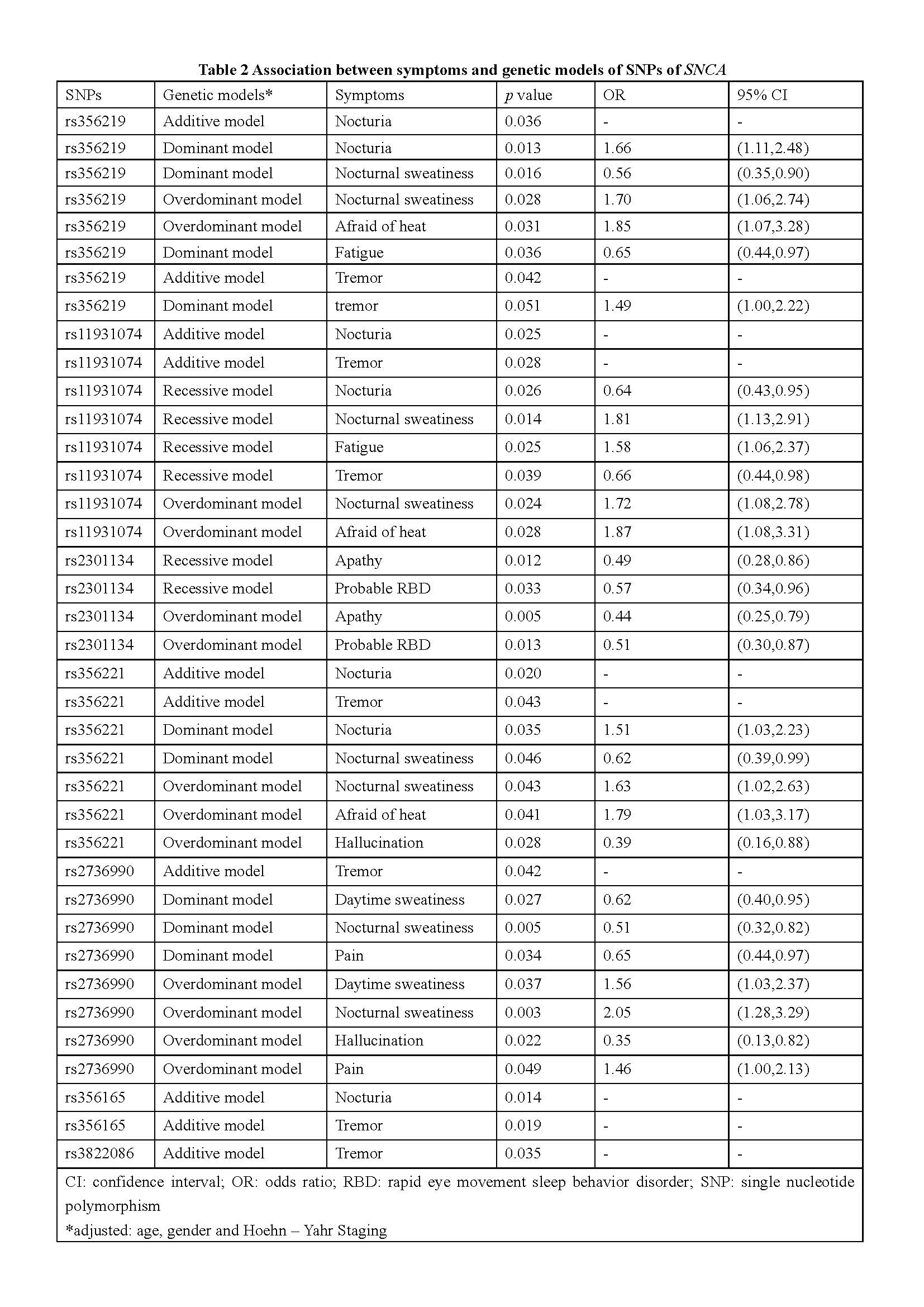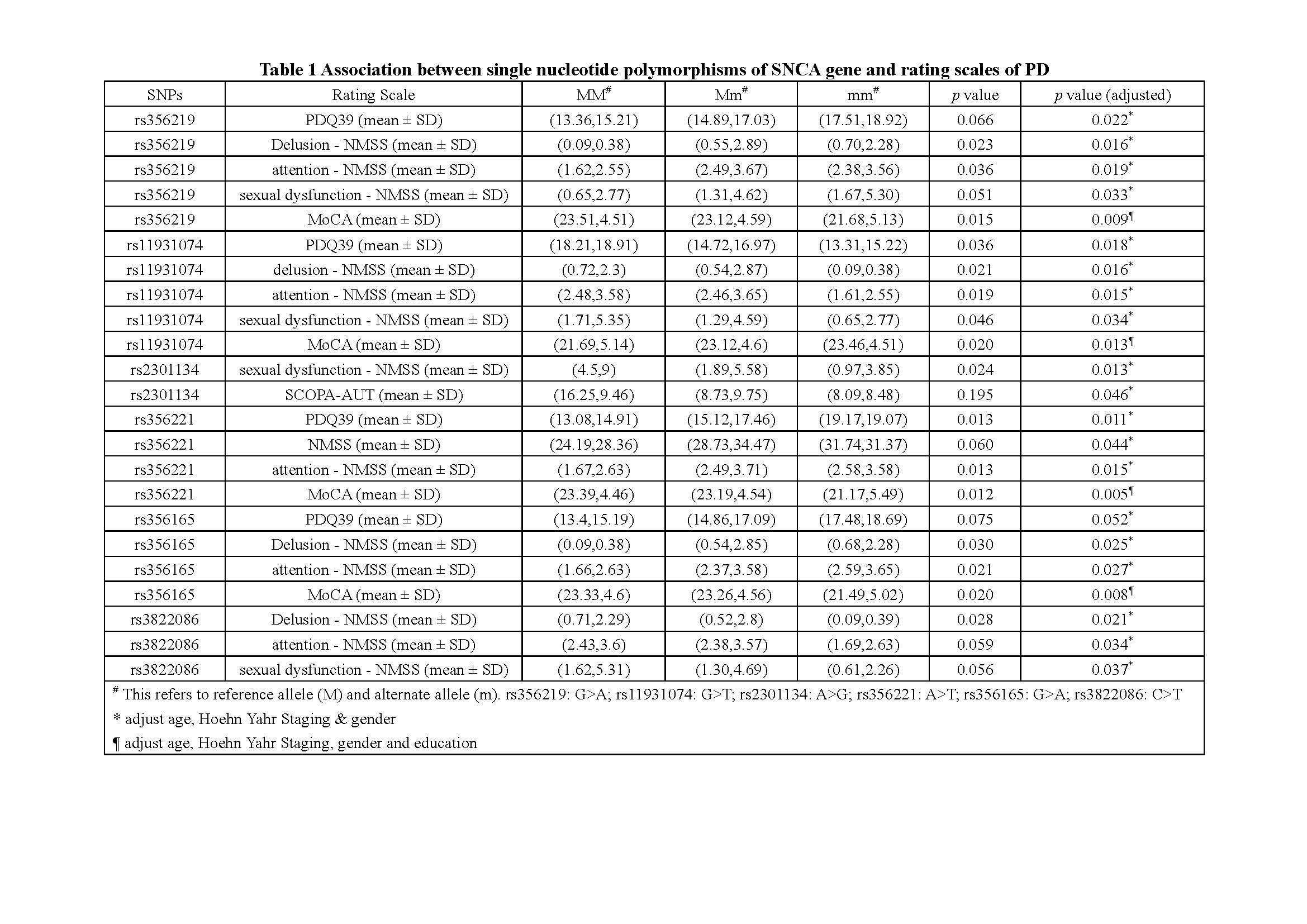Category: Parkinson's Disease: Genetics
Objective: The aim was to investigate the association between SNCA and clinical phenotypes of Parkinson’s disease (PD) in southern Chinese.
Background: SNCA gene plays an important role in the pathogenesis of PD. Discovering the relationship between SNCA and the presence of phenotypes could help us make better understanding of function of SNCA.
Method: In all, 511 PD patients were recruited in this study. All patients were evaluated by Sniffin’ Sticks 16 (SS-16), Hamilton anxiety rating scale (HAMA) and Hamilton depression rating scale (HAMD) , 39-item Parkinson’s disease Questionnaire (PDQ-39), Non-Motor Symptom scale (NMSS), Scales for outcomes of PD – Autonomic scale (SCOPA-AUT), Mini-Mental Status Examination (MMSE) and Montreal Cognitive Assessment (MoCA) (Beijing Version). Symptoms were also recorded in the binary way. ANOVA was used to assess the relationship between rating scales and genotypes. Analysis of covariance was used to assess the relationship between rating scales and genotypes. Age, Hoehn-Yahr staging, gender and education were regarded as covariance in the comparison between MMSE/MoCA and genotypes. Age, Hoehn – Yahr staging and gender were regarded as covariance in the rest comparisons. Cochran – Armitage trend test was used to assess the relationship between symptoms and additive models of SNPs. Logistic regression was used to assess the relationship between symptoms and genetic models (dominant model, recessive model and overdominant model) of SNPs. Gender, age and Hoehn – Yahr staging were used to adjust into the logistic regression.
Results: rs3822086 and rs356165 was associated with tremor (rs356219: 0.042, rs11931074: 0.028, rs356221: 0.043, rs356165: 0.019, rs2736990: 0.042, rs3822086: 0.035). Dominant model of rs356219 was associated with nocturia, nocturnal sweatiness, fatigue and tremor (nocturia: p 0.013, OR 1.66; nocturnal sweatiness: p 0.016, OR 0.56; fatigue: p 0.036, OR 0.65; tremor: p 0.051, OR: 1.49). Recessive model of rs11931074 was associated with nocturia, nocturnal sweatiness, fatigue and tremor (nocturia: p: 0.026, OR: 0.64; nocturnal sweatiness: p: 0.014, OR: 1.81; fatigue: p: 0.025, OR: 1.58; tremor: p: 0.039; OR: 0.66).
Conclusion: SNCA was associated with life quality, delusion, decreased attention, sexual dysfunction, and cognitive function. As for symptoms, genotypes of SNCA were associated with tremor, nocturia, nocturnal sweatiness, apathy and RBD.
To cite this abstract in AMA style:
G. Li, SS. Cui, P. Huang, S.D Chen, YY. Tan. Association between SNCA and clinical phenotypes of Parkinson’s disease in southern Chinese [abstract]. Mov Disord. 2020; 35 (suppl 1). https://www.mdsabstracts.org/abstract/association-between-snca-and-clinical-phenotypes-of-parkinsons-disease-in-southern-chinese/. Accessed December 18, 2025.« Back to MDS Virtual Congress 2020
MDS Abstracts - https://www.mdsabstracts.org/abstract/association-between-snca-and-clinical-phenotypes-of-parkinsons-disease-in-southern-chinese/


